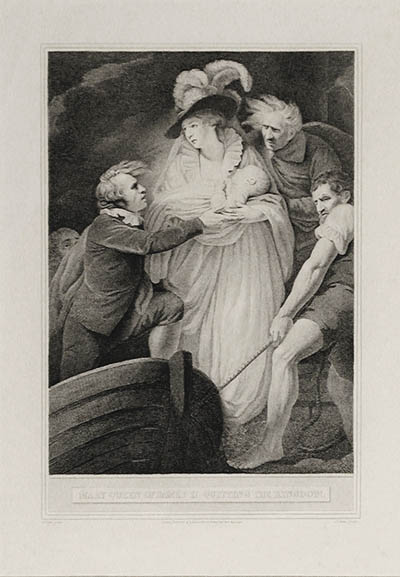| Title: |
Mary Queen of James II, Quiting The Kingdom |
| Engraver: |
Stow, James (Maidstone, 1769 - London, 1825) |
| Designer: |
Opie, John (St. Agnes, Cornwall, 1761 - London, 1807) |
| Date: |
1796 |
| Medium: |
Original Line Engraving |
| Publisher: |
R. Bower, Historic Gallery, Pall Mall, London |
| Note: |
James Stow: The son of a poor laborer, James Stow showed
such an early aptitude for art that he was apprenticed as a teenager
to the famous line engraver, William Woollett (1735-1785). On the death of his master,
James Stow became a primary assistant to William Sharp and worked on many of
his engravings. As early as 1790 James Stow was creating his own engravings
and was so highly regarded that he began receiving some of the most important
commissions of the day. These included works for John Boydell's ‘Shakespeare
Gallery’ and for Robert Bowyer's ‘Historic Gallery’ This
latter series, published throughout the 1790's, depicted images
based upon important episodes in British history. This large, original
engraving, of course, deals with the escape of Mary Queen of Scots and
was one of the finest engravings from the ‘Historic Gallery’. |
| |
In Mary Queen of James Quitting the Kingdom, James Stow's
talents at rendering both detail and tonal values clearly shows why his
services were so highly sought after. Indeed, few late eighteenth century
engravings can compete with this example for its sheer skill and artistry.
Unfortunately, James Stow's abilities declined sharply after the beginning
of the nineteenth century. He is said to have fallen into “dissipated
habits” * and died leaving his family in poverty. |
| |
John Opie: Born in a remote Cornish village,
John Opie was slated to follow in his father's footsteps and become a carpenter.
His boyhood talent for drawing, however, came to the attention of the Truro
painter, Dr. Wolcott, who encouraged John Opie to pursue a career as a portrait
painter. John Opie first came to London in 1780 and immediately received
commissions for his portraits. |
| |
By 1790 John Opie had emerged as a major artist of historical and literary
scenes. His accomplishments in these fields put him in great demand from
the major publishers of the day, such as Boydell and Macklin. In 1806 John
Opie succeeded Fuseli as Professor of Painting at the Royal Academy. |
| Reference: |
* G. C. Williamson, Bryan’s Dictionary of Painters
and Engravers, London, Bell & Sons, 1934, Vol. V, p. 134. |
| Size: |
15 X 11 (Sizes in inches are approximate,
height preceding width of plate-mark or image.) |
| |
Matted with 100% Archival Materials |
| Condition: |
Printed upon late 18th century wove paper and with large,
full margins as published by Bowyer in London in 1796. Apart from faint
foxing in the margins this is a fine, early impression and in very good
condition throughout. Mary Queen of James Quitting the Kingdom stands
as a prime, original example of late eighteenth century British line
engraving. |
| Price: |
Sold - The price is no longer available. |
| Important Information: |
The artist biographies, research and or information pertaining to all the original works of art posted on our pages has been written and designed by Greg & Connie Peters exclusively for our site, (www.artoftheprint.com). Please visit us regularly to view the latest artworks offered for sale. We will soon be posting an update of our most recent research and include the biographical and historical information pertaining to our next collection of original works of art created by artists throughout the centuries. We hope you found the information you were looking for and that it has been beneficial.
Our Gallery, (Art of the Print / www.artoftheprint.com) guarantees the authenticity of every work of art we sell 100%. Full documentation and certification is provided. We offer a wide selection of international fine art dating from the early Renaissance to the contemporary art period. |



![]()
![]() or
phone Greg & Connie (905) 957-6666
or
phone Greg & Connie (905) 957-6666